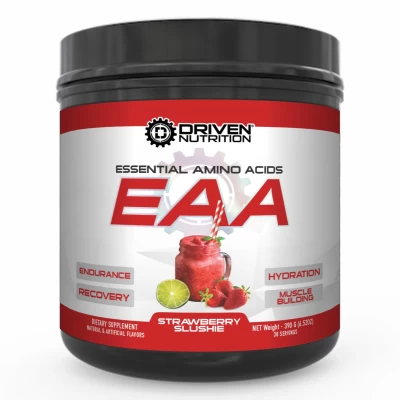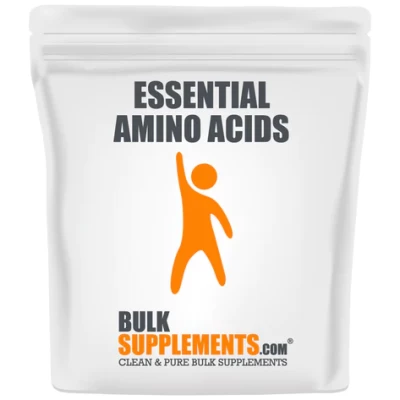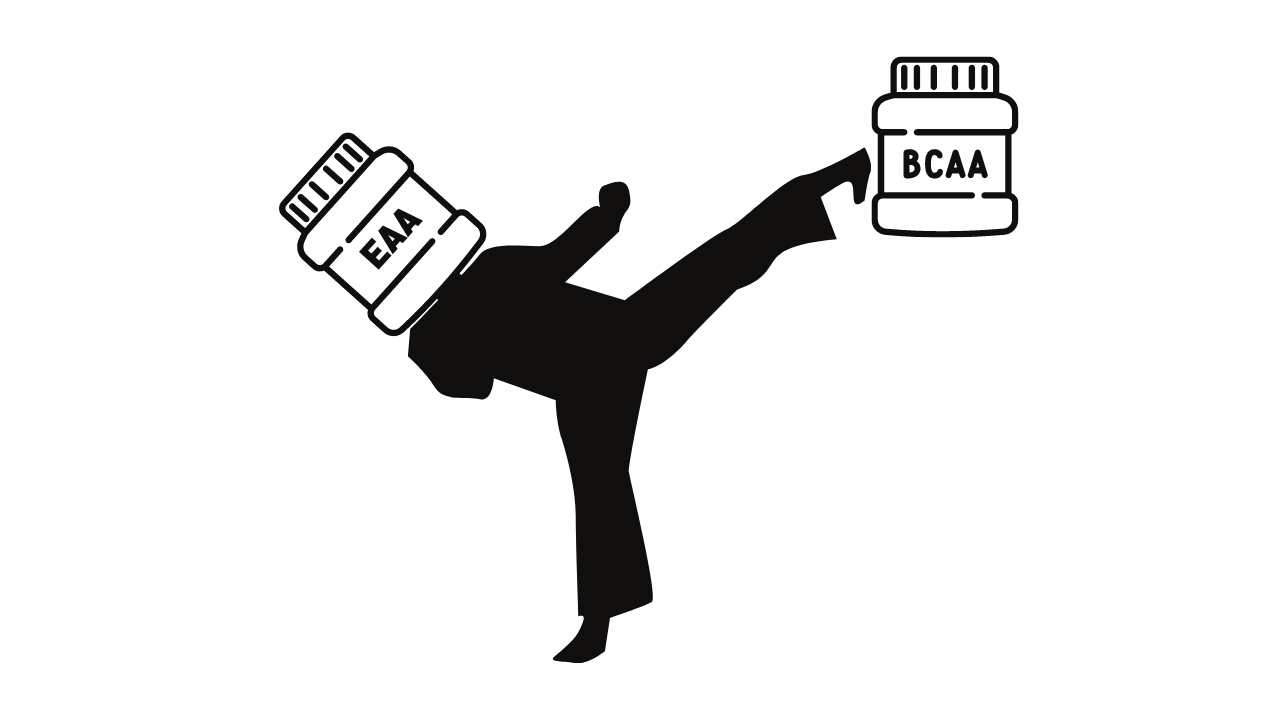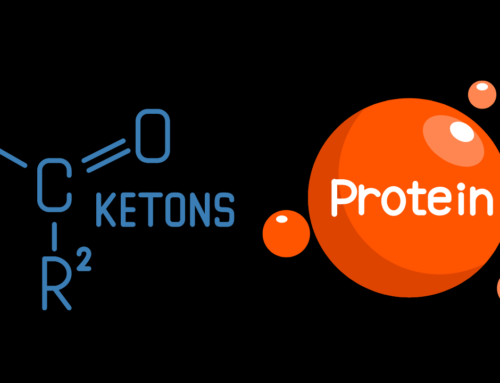Poke around the internet and it gets confusing in the land of supplements
Here is a question I got the other day.
“Hey doc, I heard that BCAAs are not useful at all for adding muscle. Is this true? Thanks.” – Mark
If you are old like me, you remember back to the stone age when branch chain amino acids (BCAAs) were all the rage. They were in pre-workouts, intra-workouts, and post-workout supplements.
But Are BCAAs Really That Useful to Add New Muscle?
Let’s back up and review the 3 key nutrition factors to add new muscle then tackle the BCAA question.
Think of building muscle as an assembly line.

Step 1 in Building New Muscle
Turn on the assembly line of muscle; the key there is the amino acid leucine at a dose of around 2-3 grams at once (1-3).
Step 2 in Building New Muscle
You need building blocks to build stuff -your body literally needs new amino acids to shove into muscle tissue, these are the essential amino acids (EAAs) (4-5). EAAs serve as the building blocks.
Hint – this is where BCAAs fall short; they do not have all the EAAs.
Step 3 in Building New Muscle
You need energy to run it!
You may be able to divert some from stored fat, and glucose (stored in the liver and muscle as glycogen), but if you want to maximize this muscling building process, you will need to be in a calorie surplus. How much of a surplus is up for debate and is another article in itself.
In the Flex Diet Cert, I did recommend the use of BCAAs as a way to bump up the quality of lower-level proteins (most vegan proteins, cough cough). This was using BCAAs just for their leucine content.
My bias is that BCAAs are ok at best. Their only shining point is that they are a good source of the amino acid leucine. EAAs will be better overall than BCAAs.
Another advantage of EAAs is you can take them right before training when you are worried that protein may not sit well /result in digestion issues. No need to crop dust the entire gym.
EAA Option 1: You Value Taste
If you are looking for a good source of EAAs in a product that tastes good, my go-to is the Driven Nutrition EAAs below.
>> EAAs from Driven Nutrition <<
Use the code “drmike” to save 15% on anything there

EAA Option 2: Save Me $$, Screw Taste
If you are on a budget and want to use EAAs – you can get them as raw EAAs from Bulk Nutrition. This is only for the hardcore as they do not taste good, and smell like cat piss. How is that for a “sales pitch”, haha. I use these also, but only when I am going to mix it with a bit of lemon juice and slam it or n a pre-workout.
>> RAW EAAs from Bulk Nutrition <<
Used code “drmike” to save 5% on anything there

Nerdy nutrition for more muscle!
PS – I am an affiliate for both companies so I make a few coins if you purchase from my links, but you save $$ too. I use both products personally.
Rock on!

Dr. Mike T Nelson
References:
1. Norton, L. E., Wilson, G. J., Layman, D. K., Moulton, C. J., & Garlick, P. J. (2012). Leucine content of dietary proteins is a determinant of postprandial skeletal muscle protein synthesis in adult rats. Nutrition & metabolism, 9(1), 67.
2. Breen, L., & Churchward-Venne, T. A. (2012). Leucine: a nutrient ‘trigger’ for muscle anabolism, but what more?. The Journal of physiology, 590(9), 2065–2066.
3. Norton, L. E., & Layman, D. K. (2006). Leucine regulates translation initiation of protein synthesis in skeletal muscle after exercise. The Journal of nutrition, 136(2), 533S–537S.
4. Rasmussen, B. B., Tipton, K. D., Miller, S. L., Wolf, S. E., & Wolfe, R. R. (2000). An oral essential amino acid-carbohydrate supplement enhances muscle protein anabolism after resistance exercise. Journal of applied physiology (Bethesda, Md. : 1985), 88(2), 386–392.
5. Kato, H., Suzuki, H., Mimura, M., Inoue, Y., Sugita, M., Suzuki, K., & Kobayashi, H. (2015). Leucine-enriched essential amino acids attenuate muscle soreness and improve muscle protein synthesis after eccentric contractions in rats. Amino acids, 47(6), 1193–1201.
6. Morton, R. W., McGlory, C., & Phillips, S. M. (2015). Nutritional interventions to augment resistance training-induced skeletal muscle hypertrophy. Frontiers in physiology, 6, 245.
7. Churchward-Venne, T. A., Burd, N. A., & Phillips, S. M. (2012). Nutritional regulation of muscle protein synthesis with resistance exercise: strategies to enhance anabolism. Nutrition & metabolism, 9(1), 40.
8. Atherton, P. J., Smith, K., Etheridge, T., Rankin, D., & Rennie, M. J. (2010). Distinct anabolic signalling responses to amino acids in C2C12 skeletal muscle cells. Amino acids, 38(5), 1533–1539.

Dr. Mike T Nelson
PhD, MSME, CISSN, CSCS Carrick Institute Adjunct Professor Dr. Mike T. Nelson has spent 18 years of his life learning how the human body works, specifically focusing on how to properly condition it to burn fat and become stronger, more flexible, and healthier. He’s has a PhD in Exercise Physiology, a BA in Natural Science, and an MS in Biomechanics. He’s an adjunct professor and a member of the American College of Sports Medicine. He’s been called in to share his techniques with top government agencies. The techniques he’s developed and the results Mike gets for his clients have been featured in international magazines, in scientific publications, and on websites across the globe.
- PhD in Exercise Physiology
- BA in Natural Science
- MS in Biomechanics
- Adjunct Professor in Human
- Performance for Carrick Institute for Functional Neurology
- Adjunct Professor and Member of American College of Sports Medicine
- Instructor at Broadview University
- Professional Nutritional
- Member of the American Society for Nutrition
- Professional Sports Nutrition
- Member of the International Society for Sports Nutrition
- Professional NSCA Member










Leave A Comment